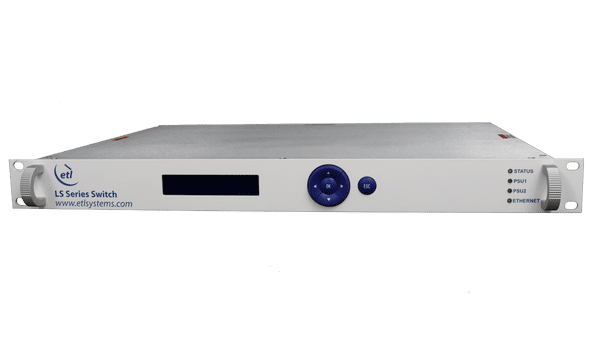
ETL Switches
Versatile, reliable switches for
L-band, IF, Broadband and SHF frequencies


ETL Switches
For all RF switching applications
ETL offers a broad range of switches covering L-band, IF, Broadband and SHF frequencies. Applications include LNB and modulator redundancy switching, antenna redundancy switching and carrier monitoring.
Solid-state and coaxial relay technology is used in our switches – dependent on functionality and frequency range. Most switches include local and remote control and some include RF level detection and automatic switchover in the event of a level drop.

Advanced control & security

Space and cost efficiency

Enhanced flexibility

Secure remote control & monitoring
The GENUS habitat offers improved security aspects (SNMPv3 and HTTPS) while maintaining an industry-leading module density, with 17 module slots available in the 1U chassis. These upgrades make GENUS a highly secure and efficient solution for demanding applications.

Save rack space & cost
The GENUS chassis integrates StingRay RF over Fibre, ETL’s Falcon frequency converters, ALTO amplifiers, switches, splitters, and small RF matrices/routers, all within a single indoor or outdoor chassis. This consolidation reduces costs, saves rack space, and enhances system resilience.
GENUS Chassis Compatible
The smart chassis concept allows for the housing of multiple RF modules within the same shelf, providing space savings, reduced costs, and increased rack space efficiency.
All of the above modules can be housed in outdoor units.

4 Switch Families Available
for GENUS, Griffin, LS-Series or SHF
ETL provides an extensive selection of switches spanning L-band, IF, Broadband, and SHF frequencies, catering to applications such as LNB and modulator redundancy switching, antenna redundancy switching, and carrier monitoring. Our switches leverage both solid-state and coaxial relay technologies, tailored to specific functionalities and frequency ranges. Many of these switches feature local and remote control, with some models incorporating RF level detection and automatic switchover to ensure continuous operation during signal drops.
ETL Switch Ranges
Explore a diverse range of RF switches tailored to specific needs. The GENUS Switch offers hot-swappable modules, secure protocols, and broad frequency support. The Griffin Switch provides robust 2×1 redundancy, RF level detection, and remote RJ45 Ethernet control in a compact 1U form. For satellite signals, the LS-Series Switch offers L-Band configurations with dual redundant PSUs and remote management. ETL’s SHF switches cover DC to 40GHz with coaxial relay or PIN Diode technology for local and remote control. Customised options ensure precise solutions for unique RF management needs.




Hot Swappable Modules
Hot swappable modules offer significant benefits in ground segment systems by enabling the replacement or upgrade of hardware components without interrupting service or powering down equipment.
This feature is crucial for maintaining continuous operation, particularly in mission-critical environments such as satellite communication, where downtime can lead to data loss or disruption of services. Hot swappability ensures swift and efficient maintenance, reducing repair times and operational costs while enhancing system reliability and uptime. Additionally, it allows for easy scalability and flexibility, enabling ground stations to adapt quickly to changing technology and capacity requirements.

Secure protocols with SNMPv3 and HTTPS
Implementing secure protocols like SNMPv3 and HTTPS in network management provides substantial benefits by ensuring the safety and integrity of data communications. SNMPv3 (Simple Network Management Protocol version 3) enhances security through robust authentication and encryption mechanisms, protecting network devices from unauthorised access and tampering. It also supports fine-grained access control, allowing administrators to precisely manage user permissions.

Meanwhile, HTTPS (Hypertext Transfer Protocol Secure) encrypts data transmitted over the internet, safeguarding sensitive information from interception and attacks during remote access and control of network devices. Together, these protocols help protect critical infrastructure from cyber threats, enhance compliance with security standards, and foster trust in network management practices. By securing both local and remote communication channels, they provide a resilient foundation for reliable and secure operations in modern networking environments.
Local & Remote control & monitoring
Local and remote control and monitoring capabilities provide essential advantages in managing complex systems and networks. Locally, operators can directly oversee equipment status, troubleshoot issues promptly, and make real-time adjustments to optimise performance. This immediate access is critical for maintaining operational continuity and responding swiftly to changing conditions or emergencies.

On the other hand, remote control and monitoring extend these capabilities beyond physical proximity, allowing administrators to manage devices and systems from virtually anywhere. This flexibility enhances operational efficiency by reducing the need for on-site interventions and enabling proactive maintenance and upgrades. Additionally, remote monitoring provides insights into long-term performance trends, enabling data-driven decision-making and predictive maintenance strategies. Overall, the combination of local and remote control and monitoring empowers organisations to maximise uptime, ensure regulatory compliance, and deliver reliable services to end-users.
Free Technical Support
ETL’s product support service offers comprehensive assistance to ensure optimal performance of your equipment. Customers receive free access to our UK-based technical support team, staffed by experienced engineers with in-depth knowledge of ETL products. Our support includes advice on installation, configuration, operation, and maintenance, as well as diagnostic and troubleshooting help. We also provide identification and supply of replacement parts, along with free software updates to keep systems running smoothly.

Need help selecting the right RF Solution for your project?
Only a selection of our products are listed on the site. If you can’t find what you’re looking for or have specific requirements, our team is here to assist you in finding the perfect solution.

GENUS Swift Switches
Modular Switches
The GENUS Swift Switch delivers exceptional versatility and reliability for RF signal management, featuring hot-swappable modules, secure control protocols, and support for a wide range of frequencies.
- DC- 40GHz frequency range
- 2×1 and 4×1 options
- Multiple modules per chassis
- Used for 1+1 or 2+1 configurations
- Hot swap
- Outdoor Chassis housing option
- 1U and 2U module options
- Superior specifications
- Secure protocols with SNMPv3 and HTTPS
- Local & Remote control & monitoring via RJ45 Ethernet port and web browser interface

Datasheets
Griffin Switches
Redundancy
The Griffin Switch offers robust 2×1 redundancy, seamless RF level detection, and remote management via RJ45 Ethernet for efficient broadcast signal control in a compact 1U chassis.
- Compact 1U chassis
- 2×1 redundancy switches
- DC-2450MHz
- ASI & optical redundancy switch module options
- Latching relay switches
- RF level detection
- DC & 10MHz pass
- Remote control & monitoring via RJ45 Ethernet port and web browser interface
LS-Series
Monitoring or Redundancy Switches
The LS-Series Switch provides versatile L-Band switching configurations from 8×1 to 1×32 in a compact 1U chassis, supporting both 50 ohm and 75 ohm setups, with dual redundant PSUs and remote management via RJ45 Ethernet for reliable satellite signal management.
- Compact 1U chassis
- 8×1, 1×8, 16×1, 1×16, 32×1, 1×32 sizes
- L-Band frequency range
- 50 ohm or 75 ohm
- Remote control & monitoring via RJ45 Ethernet port and web browser interface
- Dual redundant PSU’s
SHF Switches
Super High Frequency
ETL’s SHF switches cover the frequency range DC to 40GHz and are available in a range of capacities. They are coaxial relay or PIN diode-based and can be locally and/or remotely controlled.
- 8×1, 1×8, 16×1, 1×16, 32×1, 1×32 sizes
- DC-40GHz frequency range
- Latching relay switches
- Remote control & monitoring via RJ45 Ethernet port and web browser interface
- 50 ohm
- Dual redundant PSU’s
Learn more about this product range
Get in touch with our sales team to learn how our RF and Digital IF products could work for you.
FAQs
Solid state switches will lose signal transmission when the unit is not powered. In contrast, mechanical switches maintain signal passage even without power.
Mechanical switches are bi-directional, meaning they allow signal transmission in both directions. Solid-state switches, however, are not bi-directional and are typically designed for unidirectional signal flow.
An Absorptive Switch includes a 50 Ohm terminator at the output ports to match system impedance, minimising signal reflections. A Reflective Switch lacks internal termination at the output ports, potentially causing signal reflections.

Get in touch
Whether you’re starting a new project or need expert guidance, we’re here to find the perfect solution for your needs. Reach out to us now and start the conversation!
